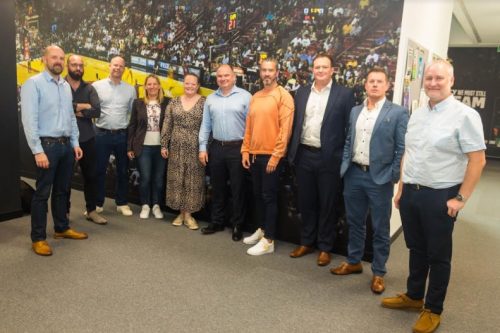Disruption as a strategy – the key challenges

While disruptive ways of working can offer attractive avenues of advance for businesses, even the most agile, forward-looking firms continue to face hurdles.
The latest roundtable, chaired by TheBusinessDesk.com’s Yorkshire editor Andrew Staples, gave participants a chance to identify some of the biggest barriers and what should be done to break through them.
The event was hosted by sports data and digital media firm DAZN, at White Rose Office Park, and sponsored by Clarion, BHP and Brown Shipley.
Phil Harris, executive director at private bank Brown Shipley, said companies must still contend with finding enough human capital and talent to turn their innovative ideas into reality.
“How do you engage with the universities, colleges and schools and bring in younger people who think differently to our generation?” he asked.
“I’ve talked to a couple of tech entrepreneurs who left university because the things they were studying were so outdated. They said, ‘we’re so far ahead of our tutors, that’s why we want to get into industry'”.
Charlotte Bailey, chief operating officer at Pan Intelligence, agreed this was a problem.
She said: “Some of our universities are not actually servicing the future because their tech stacks are too old.
“As business owners we have a responsibility to try and change the future because if we don’t your computer specialists who are coming out of universities aren’t going to find jobs because they are so behind the curve.”
Bailey said the job market is currently challenging, with people being very cautious about switching jobs. But she added businesses do not always help themselves when trying to hire staff.
“Some job specifications are so outdated, asking for so many years in the industry, even when the technology hasn’t existed for that long,” she said. “Having transferable skills is more important.”
Hurdles in the path of attracting investment were highlighted by several roundtable participants.
Paul Brook, chief executive officer of Conductive Transfers Ltd, said universities with skilled bid writers could often gain useful grants – even when this funding ends up achieving little.
In contrast, commenting on his own company’s experience, he said: “We’ve gone for innovation grants in the past but been unsuccessful. One time, we applied three times for a particular grant but still didn’t get it.
“The money we’ve used for working on R&D is money we’ve made from profits and put back into the business. We’ve never really had any investment. We had some angel funding really early on.”
Stuart Warrington, CEO of virtual demonstration software company, Envoke, said his business had struggled with the process of claiming Research & Development tax relief.
He said: “We stopped making R&D claims. All our R&D claims were audited by HMRC last year and the process was so tortuous.
“I think there were four different committees I had to go through to explain what my technology does. And we just said ‘we’re not doing this again.’ It was so painful.”
However, other business leaders noted successfully seeking investment is not necessarily the way ahead.
Phil Neale, co founder and managing director of Tabology, said: “We’ve never gone out to seek a big investment. But we’re profitable and in control of what we’re doing.
“I feel like if we raised a huge amount of money we’d then try to build a load of stuff faster than we could find out what people need. We’re careful about how we grow and don’t think a big investment is right for us now.”
Jonathan Sims, partner at Clarion, said: “If you have an institutional investor it changes your entire culture – it’s a very different journey.
“It’s a marriage at the end of the day, you’ve got to find the right investor.”
Jason Mace, founder and chief executive officer of Gala Technology, said: “Getting investors isn’t always a great move.
“A lot of the time you put in trying to get investors, you can instead concentrate on your sales. Because if you’re getting the sales you’ve got the money to reinvest and you don’t need outside investors.”
The familiar topic of red tape and bureaucracy reared its head, with speakers warning current regulatory frameworks are too cumbersome to react to the fast changing requirements of business innovation.
Jamie Williams, partner at BHP, said: “We want to adopt analytics AI because we can then take all the data out of your company, we can interrogate all your transactions.
“But we can only go as far as the regulator is comfortable with, because they don’t understand it.”
“We’re part of lobbying group with other independent accountants. We use it to push the regulator all the time. We’re hoping to get them to at least understand what this technology is so we can start using it.”
Lisa Johnson, director of autonomous robotics company Starship Technologies, said it was difficult to achieve regulatory change when senior Government ministers with decision making powers are replaced so frequently. “You just hit a political wall,” she said.
She added: “Its a huge challenge for disruption – legislation and technical standards always lag behind innovation.
“Standards, regulation, technical specifications must keep up and be a supportive regulatory framework. Because often what we’re finding is they work to shut down innovation rather than support it.”
Participants were asked about the potential benefits of collaborating with other likeminded businesses to help bypass the obstacles they face.
Warrington pointed out: “The challenge of speaking to likeminded companies is that everyone suddenly starts checking where their wallet is because they don’t want you to steal their clients. So you feel isolated.”
Mark Mildren, director of the future and head of marketing at Munroe K, said his business is aiming to foster collaboration by developing a new innovation hub at White Rose Park.
He explained: “Part of that will see the entire 20-acre park become a real world living lab test bed. We’ll invite innovators and disruptors to test and develop their technologies here.
“We’re trying to create an eco system of likeminded businesses who have shared problems. We have the the assets, the land and the infrastructure.
“It’s about the getting the right people around the metaphorical table and having those conversations to make sure we’re creating something people need, rather than what we think they need.”











